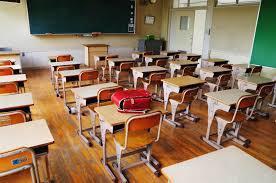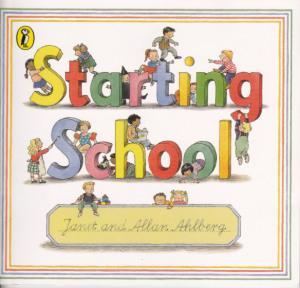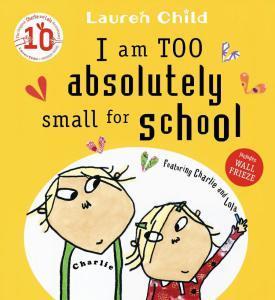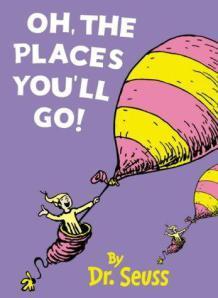
image from wikimedia commons
A version of this post was ready to go two weeks ago, when it would’ve been much more useful than it is now, but WordPress is a cruel mistress and it ate my draft before I could hit ‘publish’. No amount of cursing and fist shaking could get it back. This is a condensed version of that post. I hope it is still helpful.
Around this time of year, four- and five-year-olds across the country and across the globe are getting ready to enter Reception class for the first time. Some will have had Early Years education in a formal setting such as a nursery, and perhaps find the transition to ‘big school’ easier because of it, but many will not. It can be a daunting time for parents and children alike.
Books, as ever, can help ease the transition process by addressing fears and giving children an opportunity to ask questions, demistifying what the first stages of formal education are about and maybe even making the prospect of school an exciting, rather than a terrifying one.
The books I’ve chosen here each approach the subject in different ways, allowing parents and carers to tailor their approach to the specific needs of their own little student.
Starting School, Janet and Allan Ahlberg

Starting School
It is widely agreed upon that, in the field of kidlit, the Ahlberg’s can do no wrong. Working together and individually, they have produced eighty-something works for young readers ranging from poetry (such as Heard it in the Playground) to post-modern picture books (like Peepo! and Goldilocks, storybooks (such as Burglar Bill and the Happy Families series) for emerging readers and novels (such as Woof!) middle grade lone readers.
Starting School (1988) has few of the metafictive elements that the Ahlberg’s are famous for in their books. It’s a linear narrative presented in a traditional fashion and it helps little ones imagine what their own first days in school will be like.
The book provides an overview of a typical week in a British primary school. The children hang their coats on pegs, have a PE class in the hall, eat lunch and play with the class pet. There’s a reading corner, a dressing up box, a carpet for storytime. It’s by no means exciting, but it’s not meant to be. It’s built to reassure children about what will lie ahead of them. Janet Ahlberg’s calming illustrations fill the page and offer plenty of action to supplement the text. There are children joining in and children holding back. There are accidents, messes made and a teacher who sometimes gets a little bit cross.
The classroom in Starting School could be any classroom in the UK; this is how it demystifies the first few weeks in compulsory education. But there is a secondary asset in the book: the size and shape of the text and the construction of the page also echoes the style of Oxford Reading Tree and similar reaching schemes which children will encounter at the beginning of their academic career, perhaps providing a level of comfort when learing to read begins.
I am Too Absolutely Small for School, Lauren Child

I am Too Absolutely Small for School
Articulating concerns can be difficult when your language and cognitive skills are in their infancy. Here, Lauren Child’s spectacularly successful Charlie and Lola series can help.
Graphically and narratively simple, I am Too Absolutely Small For School (2003) relates Lola’s worries as she prepares for her first day at school. She doesn’t need to go to school because she can already count to ten and anyway she’s got lots of important things to do at home. Charlie acknowledges these statements and counters them with logical, if somewhat surreal arguments of his own.
When Lola is convinced that she might benefit from going to school, her argument changes tack. Vocalising her thoughts through her invisible friend Søren, Lola begins to acknowledge her real fear: being outside the safety of the home. “Søren Lorensen is a bit slightly nervous to be at school on his own,” she admits.
On the first day of school Lola is a bit ‘wobbly’ and her brother is concerned, but of course she has a marvelous time and makes a friend. Children will be able to relate to Lola’s fear of owning her feelings, and will find in the text prompts to help them talk about their own.
With mixed-media illustrations that draw the eye across the page I am Too Absolutely Small for School is an engaging read that offers youngsters an opportunity to see a character that they may already know well – aside from the books an animated show produced between 2005 and 2008 is still repeated on CBeebies – reflecting their own experience and making them feel less alone.
Oh, The Places You’ll Go!, Dr Seuss

Oh, the Places You’ll Go!
While not strictly a book about beginning school, the last book published by Theodore Geisel, or Dr. Seuss as we know him, before his death is an ideal book for getting children excited about setting out on new adventures.
Oh, the Places You’ll Go! (1990) is often given as a graduation gift but it’s equally appropriate at the beginning of a scholastic career. With Seuss’s trademark use of language and scratchy, colourful illustrations, the books speaks of an unknown future in which anything is possible.
The text is joyous, playfully lyrical (the text is written in anapestic tetrameter) and has an honestly that prevents it becoming too saccharine. The message is: you are smart, you can do this. Seuss doesn’t shy away from the more frustrating side of life. There will be mistakes, he says, and crossroads where you don’t quite know what to do. By acknowledging that bumps will appear in the road ahead and that fear, loneliness and confusion are inevitable, Seuss’s promise that you have the ability to succeed is infinitely more believable.
Education is the first step on this journey; it’s often the first time youngsters are out of a domestic environment for significant periods of time and it can feel very much like you’re on your own. Oh, The Places You’ll Go! reminds readers that what lies ahead of them is difficult but probably worth it. It’s an energising read that’s excellent about getting kids excited
Bonus material: The people at Burning Man 2011 read Oh, The Places You’ll Go!
Honorable mention goes to Come to School Too, Blue Kangaroo! by Emma Chichester Clark which I have not read, but which has an excellent reputation.
